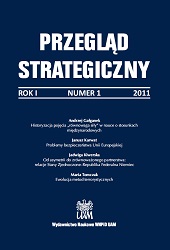STRATEGICZNE DYLEMATY SOJUSZU PÓ£NOCNOATLANTYCKIEGO
THE STRATEGIC DILEMMAS OF THE NORTH ATLANTIC ALLIANCE
Author(s): Krzysztof MalinowskiSubject(s): International relations/trade, Security and defense, Military policy
Published by: Uniwersytet Adama Mickiewicza
Keywords: NATO; OTAN
Summary/Abstract: In the aftermath of the Iraq crisis, the North Atlantic Alliance faced its most serious predicament since the ColdWar. Its mission in Afghanistan revealed growing discrepancies between the member states. The Georgian crisis of 2008, the missile defence project and the enlargement showed a lack of coherence. NATO has split up into two or more factions. A crucial question arose as to NATO’s ability to resolve the three main strategic dilemmas which have grown more pressing since the end of the ColdWar: (1) the choice between collective defence as the key role of NATO (Art. 5) and its out-of-area role of combating the proliferation of weapons of mass destruction and international terrorism; (2) the choice between the transatlantic nature of NATO and its global partnerships; (3) the choice between the concept of the global military engagement of NATO and the so called comprehensive approach involving the cooperation of NATO with other security organizations such as the UN, the EU and the OSCE in reconstructing post-conflict regions. NATO’s performance in managing these challenges will bear critically on its future. The Strategic Concept from Lisbon 2010 has helped to clarify many controversial issues within the organization. NATO has managed to mitigate the risk of developing into a multi-tier organization. Relations between the factions have relaxed although interests appear to remain as diverse as they were before.
Journal: Przegląd Strategiczny
- Issue Year: I/2011
- Issue No: 1
- Page Range: 151-166
- Page Count: 16
- Language: Polish

